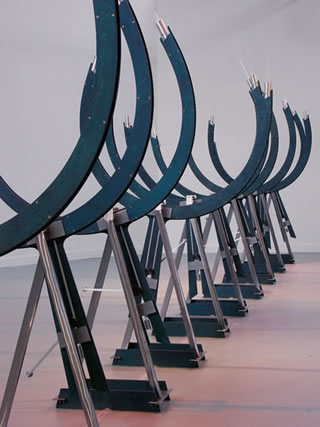Sounding the Depths
 |
|
|
It has been, surprisingly enough, a quiet revolution. Since its first burst of popularity in the mid-1950s, sound art has blossomed, with wonderfully quirky sculptures that quiver, sway, collide, and occasionally moan. They have moved into art galleries, public spaces, parks—even the occasional home.
Sound sculptures, which were pioneered and popularized by one of America's iconic mid-century designers and sculptors, Harry Bertoia, have boomed in popularity in recent years.
"It's building interest," San Francisco sound artist Tamara Albaitis says. "It's moving. It's getting bigger."
At their best, sound sculptures have the jauntiness, joie de vivre, spontaneity, and optimism that characterize modern design—and modern homes. Moving sculptures—simple in form, abstract in design, scientific in concept—could be charming additions to a home, providing not just a visual element but sounds that are relaxing—or not.
 |
|
|
It must be said, however, that the homeowners who invite in sound sculptures tend to be courageous—or is it outrageous?
"It's the kind of thing that could drive people crazy if they have to live with it," says Oliver DiCicco, a San Francisco sound sculptor and musician who also makes interior furnishings, such as tables, that stay blissfully silent. "I don't even suggest [sound sculpture] to people unless it's an outside fountain or something."
Sound art, which includes sculptures that make sound, unusual musical instruments, and artistically devised sounds with no visual accompaniment at all, has accomplished much in its short lifetime.
Sound artists have designed sculptures that play music generated by earthquakes as they occur around the globe. Each sound, moreover, is keyed to a place. "People who work there," says the artist known only as Trimpin, "can immediately hear where the earthquake is coming from.
Trimpin, whose works are often large and installed in public or semi-public spaces, has also created pieces for homes. One, a decidedly different sort of doorbell, has a sounding devise four feet tall, two feet wide, and seven inches deep; its sound-makers include a variety of toys and an accordion.
 |
|
|
The artist has also created a kind of hanging gamelan orchestra in a modern home on Lake George, New York, using 48 suspended glass bars that can be played using a keyboard or an iPhone.
Another sound artist, New Yorker Maryanne Amacher, has composed 'ear dances' using human ears to generate sounds that are part of larger melodies. The English artist Hugh Davies turned household egg-slicers into symphonic instruments.
The Bay Area artist Terry Fox created what one observer called "breathtakingly, achingly beautiful music" by playing 150-long wires stretched the length of a deserted Italian church. Paul Kos, another San Franciscan, pushed the limits of wound art by forcing audiences to listen very intently to hear ice melt.
But undoubtedly the greatest accomplishment of sound art to date is this: It has convinced fans that the world can sound like a beautiful place if we would only listen.
And, to hear sound artists talk, the triumphs are only beginning.
Over the past ten years, Trimpin says, sound art has come into its own bureaucratically. Artists can finally go after grants in the category of 'sound art,' he says. Before, groups that fund visual arts would send sound artists to groups that fund musicians and vice versa.




